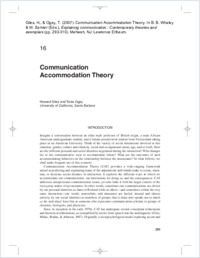Communication Accommodation Theory
- Giles, Howard University of California, Santa Barbara
- Ogay, Tania Université de Fribourg
-
2007
Published in:
- Explaining communication : contemporary theories and exemplars / Whaley, Bryan B. ; Samter, Wendy. - Mahwah, NJ: Lawrence Erlbaum. - 2007, p. 293-310
Théorie
Identité sociale
Communication interpersonnelle
Individualité
CAT
Communication
Accommodation
English
Communication Accommodation Theory (CAT) provides a wide-ranging framework aimed at predicting and explaining many of the adjustments individuals make to create, maintain,or decrease social distance in interaction. It explores the different ways in which we accommodate our communication, our motivations for doing so, and the consequences. CAT addresses interpersonal communication issues, yet also links it with the larger context of the intergroup stakes of an encounter. In other words, sometimes our communications are driven by our personal identities as Janet or Richard while at others—and sometimes within the very same interaction—our words, nonverbals, and demeanor are fueled, instead and almost entirely, by our social identities as members of groups; that is Janet now speaks not so much as the individual Janet but as someone who represents communication scholars to groups of chemists, biologists, and physicists.
- Faculty
- Faculté des lettres et des sciences humaines
- Department
- Département des sciences de l'éducation et de la formation
- Language
-
- English
- Classification
- Psychology
- License
-
License undefined
- Identifiers
-
- RERO DOC 306556
- DOI 10.4324/9781410614308-21
- Persistent URL
- https://folia.unifr.ch/unifr/documents/306470
Statistics
Document views: 523
File downloads:
- Texte intégral: 7875
